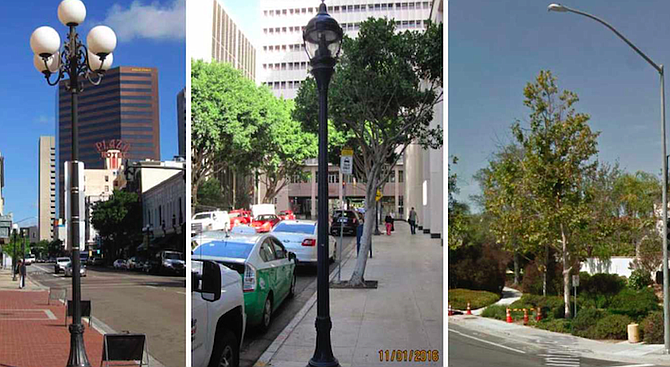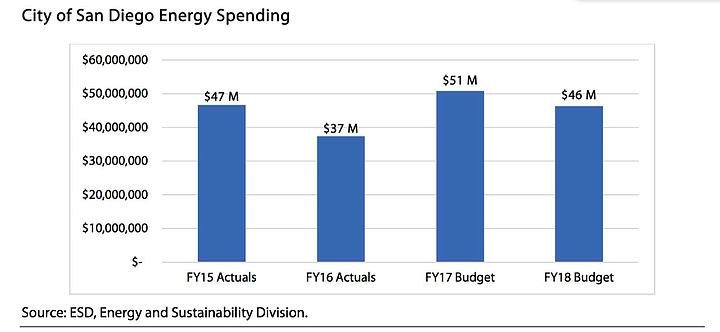 Facebook
Facebook
 X
X
 Instagram
Instagram
 TikTok
TikTok
 Youtube
Youtube

San Diego taxpayers have been overbilled by millions of dollars in energy expenses, says a new report by city auditor Eduardo Luna that fingers SDG&E and the city administration under Republican mayor Kevin Faulconer - a key beneficiary of the utility's campaign cash largesse - as bad actors in a series of chronic money drains favoring the power company.

"3,712 streetlights in SDG&E’s inventory being billed to the City," says the April 4 document, "either do not exist or are duplicates."
The ghostly situation came to light in 2013 during an inventory conducted by the city as part of a project to retrofit city streetlights with more efficient light sources known as Light Emitting Diodes.
Subsequently requested by city officials to correct the error and provide a refund, the big utility has dragged its feet, accusing the city of providing bad data.

"The Energy and Sustainability Division provided its inventory data to SDG&E and has formally requested that the utility remove the lights from billing, and provide an appropriate credit," says the audit.
"However, SDG&E does not believe Energy and Sustainability Division’s figure is accurate, and is currently coordinating with City staff to validate the information."
Much of the fault for the massive monetary bleeding lies with lax city procedures for monitoring SDG&E bills, according to Luna's report.
"Neither the Energy and Sustainability Division nor Street Division adequately review street light billing for accuracy," says the document.
"There is no established process to ensure that new street lights are billed to the correct street light account."
The audit revealed a host of other lapses leading to overcharges, putting the city at a distinct disadvantage when dealing with SDG&E, a subsidiary of giant San Diego-based Sempra Energy.
"The City is unable to isolate street light bills because many street lights are attached to traffic signals, and the City does not have an accurate street light asset inventory," according to the audit.
"Also, Street Division staff conduct only a cursory review of electricity billing data. However, based on the complexity of the City street light infrastructure and the large number of street light accounts, additional actions are necessary to ensure proper billing and payment of electrical bills."
Total costs of inflated lighting bills are difficult to obtain under the city's inadequate bookkeeping procedures, says the report.
"The City spends approximately $2 million a year on street light electricity, [but] the Energy and Sustainability Division cannot determine the exact amount spent on street light electricity because some street lights are attached to traffic signals, which are billed on their own metered SDG&E accounts."
A bevy of previous billing gaffes outlined by the document suggest that more than just ghost lamps have been costing taxpayers dearly, to the benefit of the utility company.
In one 2015 case, city officials "identified an incorrect billing that overcharged the City by $1.7 million."
According to the audit, "The amount was incorrect because when SDG&E swapped out and moved the location of three meters at a sewer pump station, the meters were assigned a default rate code instead of the correct rate code for the account."
The utility finally agreed to refund the overcharges in October 2016, the report says.
The problems go far deeper than watching bills for overcharges.
"The City has not established a designated rate analysis function to analyze energy account rates and consumption for all City accounts on an ongoing basis, and has not established a comprehensive program to ensure it makes proper payments for utility services," says the report.
The audit says that the city's Energy and Sustainability Division has plans to acquire "a new analytics and reporting system to replace the current energy account management application," with a Request for Proposal to be published this month.
"The new system will include improved analytical tools which will allow Energy and Sustainability Division to identify anomalies."
So far though, the report observes, "Only one department, the Public Utilities Department, has an established process to utilize the billing information to identify potential invoice errors. However, that process is not documented in a formal standard operating procedure. The remaining eight departments only conduct a cursory review of the data and investigate anomalies as necessary."
In sum, "The lack of policies and procedures demonstrates that a sufficient Citywide control environment has not been established for the review of utility invoices.”
A lot of tax money is on the line.
"The City owns more than 1,600 properties that total an estimated 120,000 acres. The City also owns approximately 60,000 street lights, and has over 1,500 intersections regulated by traffic signals. To power various assets, the City has budgeted about $51 million for gas and electric utilities for FY 2017, and plans to spend about $46 million in FY 2018.”
Adds the document, "SDG&E electricity rates have increased by approximately 35 percent since FY 2010, or an average of 5.4 percent annually."
An accompanying March 29 letter to Luna from Mario X. Sierra, director of city Environmental Services, agreed with the auditors' conclusions and promised to "significantly enhance the overall internal controls," by March of next year.
"A new Energy Program Coordinator position was created and filled in July 2016," according to the letter. "This position brings utility rate experience from the California Public Utilities Commission and serves as our liaison with SDG&E."
In addition, "a new Deputy Director with extensive energy policy, administration and programmatic experience was hired in August 2016. Both positions are currently evaluating existing processes and will develop written process narratives, procedures and training."


San Diego taxpayers have been overbilled by millions of dollars in energy expenses, says a new report by city auditor Eduardo Luna that fingers SDG&E and the city administration under Republican mayor Kevin Faulconer - a key beneficiary of the utility's campaign cash largesse - as bad actors in a series of chronic money drains favoring the power company.

"3,712 streetlights in SDG&E’s inventory being billed to the City," says the April 4 document, "either do not exist or are duplicates."
The ghostly situation came to light in 2013 during an inventory conducted by the city as part of a project to retrofit city streetlights with more efficient light sources known as Light Emitting Diodes.
Subsequently requested by city officials to correct the error and provide a refund, the big utility has dragged its feet, accusing the city of providing bad data.

"The Energy and Sustainability Division provided its inventory data to SDG&E and has formally requested that the utility remove the lights from billing, and provide an appropriate credit," says the audit.
"However, SDG&E does not believe Energy and Sustainability Division’s figure is accurate, and is currently coordinating with City staff to validate the information."
Much of the fault for the massive monetary bleeding lies with lax city procedures for monitoring SDG&E bills, according to Luna's report.
"Neither the Energy and Sustainability Division nor Street Division adequately review street light billing for accuracy," says the document.
"There is no established process to ensure that new street lights are billed to the correct street light account."
The audit revealed a host of other lapses leading to overcharges, putting the city at a distinct disadvantage when dealing with SDG&E, a subsidiary of giant San Diego-based Sempra Energy.
"The City is unable to isolate street light bills because many street lights are attached to traffic signals, and the City does not have an accurate street light asset inventory," according to the audit.
"Also, Street Division staff conduct only a cursory review of electricity billing data. However, based on the complexity of the City street light infrastructure and the large number of street light accounts, additional actions are necessary to ensure proper billing and payment of electrical bills."
Total costs of inflated lighting bills are difficult to obtain under the city's inadequate bookkeeping procedures, says the report.
"The City spends approximately $2 million a year on street light electricity, [but] the Energy and Sustainability Division cannot determine the exact amount spent on street light electricity because some street lights are attached to traffic signals, which are billed on their own metered SDG&E accounts."
A bevy of previous billing gaffes outlined by the document suggest that more than just ghost lamps have been costing taxpayers dearly, to the benefit of the utility company.
In one 2015 case, city officials "identified an incorrect billing that overcharged the City by $1.7 million."
According to the audit, "The amount was incorrect because when SDG&E swapped out and moved the location of three meters at a sewer pump station, the meters were assigned a default rate code instead of the correct rate code for the account."
The utility finally agreed to refund the overcharges in October 2016, the report says.
The problems go far deeper than watching bills for overcharges.
"The City has not established a designated rate analysis function to analyze energy account rates and consumption for all City accounts on an ongoing basis, and has not established a comprehensive program to ensure it makes proper payments for utility services," says the report.
The audit says that the city's Energy and Sustainability Division has plans to acquire "a new analytics and reporting system to replace the current energy account management application," with a Request for Proposal to be published this month.
"The new system will include improved analytical tools which will allow Energy and Sustainability Division to identify anomalies."
So far though, the report observes, "Only one department, the Public Utilities Department, has an established process to utilize the billing information to identify potential invoice errors. However, that process is not documented in a formal standard operating procedure. The remaining eight departments only conduct a cursory review of the data and investigate anomalies as necessary."
In sum, "The lack of policies and procedures demonstrates that a sufficient Citywide control environment has not been established for the review of utility invoices.”
A lot of tax money is on the line.
"The City owns more than 1,600 properties that total an estimated 120,000 acres. The City also owns approximately 60,000 street lights, and has over 1,500 intersections regulated by traffic signals. To power various assets, the City has budgeted about $51 million for gas and electric utilities for FY 2017, and plans to spend about $46 million in FY 2018.”
Adds the document, "SDG&E electricity rates have increased by approximately 35 percent since FY 2010, or an average of 5.4 percent annually."
An accompanying March 29 letter to Luna from Mario X. Sierra, director of city Environmental Services, agreed with the auditors' conclusions and promised to "significantly enhance the overall internal controls," by March of next year.
"A new Energy Program Coordinator position was created and filled in July 2016," according to the letter. "This position brings utility rate experience from the California Public Utilities Commission and serves as our liaison with SDG&E."
In addition, "a new Deputy Director with extensive energy policy, administration and programmatic experience was hired in August 2016. Both positions are currently evaluating existing processes and will develop written process narratives, procedures and training."
Comments